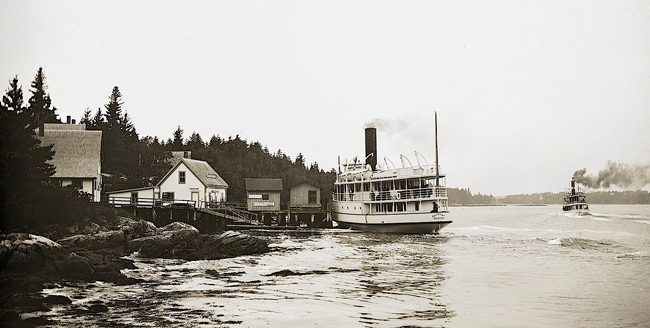B A C K T H E N
Southport Steamers
The Eastern Steamship Company’s Southport calls at a landing in her namesake town while the smaller Islander (the second of this name on the route) steams west through Townsend Gut headed for the Sheepscot River, Goose Rock Passage, Knubble Bay, and the narrow Sasanoa River (where, at Lower Hell Gate, the tide pulls the spar buoys under) on the inside passage from Boothbay Harbor to the Kennebec River.
Southport will follow Islander to Bath, from whence Islander will continue up the Kennebec to Gardiner. Southport and her sister Westport, although built for this service in 1911, proved too big, and by 1920 both had shifted to the Rockland–Blue Hill line. The last of many steamers on the route was the Virginia, in 1941.
Small steamers serving islands and peninsulas long constituted a valued social and economic institution. They operated in watery realms unknown to rail or auto travelers, and the skill and nerve required to safely pilot them in fog and darkness were surely never fully appreciated by freight shippers or passengers.
Unlike barking locomotives or puffing harbor tugs, the little steamers, fitted with condensing engines, glided along with just enough noise and vibration to reassure the timid. Memories of the sound of their whistles and the sweet smell of soft coal smoke–if not the accompanying soot–were long cherished after motor vehicles and highways did the little steamers in.
Text by William H. Bunting from Maine On Glass. Published by Tilbury House Publishers, 12 Starr St., Thomaston, Maine. 800-582-1899.
Maine On Glass and prints of the photographs are available through the Penobscot Marine Museum: PenobscotMarineMuseum.org.

